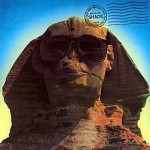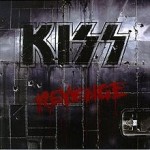[one_third][alert type=”blue”]
Released: October 17, 1989
Label: Mercury Records[/alert][/one_third]At the end of the ’80s, KISS somehow found themselves in even more of a state of disarray than at the end of the previous decade. At the end of ’70s, they at least had the benefit of having come off a huge album and top ten hit. By 1989, KISS couldn’t afford another flop. They had cleaned house with their management (some of whom had been with them since their heyday) and hired an unusual replacement to handle their business affairs…Paul Stanley’s psychotherapist, Dr. Jesse Hilsen. Hilsen’s methods were highly, highly unusual and he would often threaten to “let Paul go crazy on them” if he didn’t get his way.
With their recent albums, KISS had trouble maintaining their own identity while trying to compete with the popular hard rock bands of the late ’80s (many of whom had been inspired by KISS). Adding to this difficulty was the fact that due to the financial disappointment of Crazy Nights , the band couldn’t afford to hire an outside producer so Gene & Paul had to produce the album again. Fortunately, with his record label and acting career on the rocks, Gene’s focus was more back on the band.
Also adding to the songwriting process for the first time was Eric Carr, who got his first chance to contribute. He had long desired to become a bigger part of the creative process but for whatever reason, the songs he submitted for the albums never made the albums. Carr, who had crippling bouts of anxiety and depression, was incredibly insecure with his position in the band and was constantly asking friends if Whitesnake was looking for a drummer. Some of his concerns were assuaged when Gene took a liking to a tossed off funked up rocker Carr recorded called “Ain’t That Peculiar” (no relation to Marvin Gaye’s classic) and worked with him on rewriting it and renamed it “Little Caesar” (named after Gene & Paul’s nickname for The Fox)
A number of outside songwriters were again brought in for the album. Vini Poncia, who produced Dynasty and Unmasked for the band, came back to co-write five songs with Gene. Desmond Child came back to try and craft another super hit with Paul and the KISS obsessed lead guitarist for third tier (Simmons managed) hair metal band, Black N Blue, Tommy Thayer got to realize his dream and co-write two songs with The Demon. Bruce Kulick again played a role in the songwriting process but his biggest contribution was not there or with his lead guitarist.
Kulick got his start as the guitarist in a hard rock band in the late ’70s called Blackjack. The front man for that band was a singer named Michael Bolotin and they recorded two albums that went nowhere on the charts. By the end of the ’80s, Michael Bolotin had dropped the second O from his name and found huge success as the middlest of middle of the road blue eyed soul crooners. Kulick had continued to do session work with Michael Bolton even after Kulick became KISS guitarist and he introduced Paul Stanley to the singer who was just becoming a megastar. Bolton, for whatever reason, had always wanted a big monster power ballad for KISS and Stanley wasn’t going to turn the opportunity to have one of the biggest stars in pop appear in the credits of the new KISS album. Even if Bolton was the antithesis of what most KISS fans wanted on their album.
Hot in the Shade was released in October of 1989 and sales wise failed to live up even to the standards of Asylum and Crazy Nights. The album is incredibly disjointed and like a lot of the early albums recorded with the longer CD length in mind is way, waaaay too long. Production wise, it’s more stripped down and less poppy than the previous KISS releases but it still sees KISS as a band without an identity. Are they sensitive arena rockers like Bon Jovi? Are they just a stripped down version of the original KISS? AC/DCesque sleaze merchants? That lack of identity is somewhat apparent by the fact that this is the only KISS record not to feature the classic band logo on the front cover. The confusion over their current identity didn’t stop Gene & Paul from donning the makeup (sort of…) for the first time since they took it off six years earlier.
Fun fact: Ace’s band, Frehley’s Comet released their version of this song a week before KISS did. Even weirder is that Paul & Desmond Child originally wrote it for Bonnie Tyler of “Total Eclipse of the Heart” fame!
Surprisingly (or maybe not so), the power ballad “Forever” became KISS’ biggest hit since “I Was Made For Lovin’ You” and their last Top 10 hit ever in the US, reaching #8 on the Billboard singles chart in early 1990. Still the success failed to reignite albums sales and once again, KISS found themselves playing on some nights to sold out 20,000 arenas and then half empty venues the next. Adding to the tension of the HitS tour was the fact that Eric Carr was refusing to speak to the rest of the band after they cut his drum solo out of the set list and once again, became terrified at the prospect of losing his spot in the band. Fortunately for him, the solo was reinstated in the set list and the tour finished with a triumphant sold out appearance at Madison Square Garden in Gene, Paul, and Eric’s hometown of New York City November of ’90. Tragically though, it would be Eric Carr’s last performance with the band.
With Hot in the Shade, KISS realized that a big pop hit wouldn’t cure all of their problems. In fact, like “I Was Made For Lovin’ You”, it might have created more of them since some KISS Army members were offended by KISS blatant ploy to hit the top of the pops. To recapture the magic of their heyday and recover from the shaky ’80s, KISS would have to reunite with an old friend who had somewhat of a tarnished track record of his own. KISS were hoping to achieve success in the ’90s by reuniting with the producer of one of their strongest albums (and one of their weirdest) and have a shocking reconciliation with an old band mate.
KISS Gets Heavy
[one_third][alert type=”blue”]
Released: May 19, 1992
Label: Mercury Records[/alert][/one_third]At the dawn of the ’90s, the music scene was changing rapidly. The glitzy hair metal bands that KISS spent much of the ’80s trying to emulate were quickly killed off a by a new music scene out of Seattle. The grunge scene seemed the antithesis of what KISS stood for; they wore thrift store clothing and wrote dark, angst ridden lyrics. However, the Seattle rockers did love the heavy metal of the early ’70s and many of them like Nirvana’s Kurt Cobain and Alice in Chains’ Layne Staley grew up admiring KISS. Whereas the previous generation of hard rock bands like Motley Crue saw KISS as old dinosaurs, a lot of the grunge bands saw KISS as their childhood heroes. With this new found relevancy, KISS was eager to get back in the studio.
Unfortunately, shortly after the end of the Hot in the Shade tour, drummer Eric Carr fell ill. Medical tests initially showed nothing out of the ordinary but he was later diagnosed with a rare and unexpectedly serious type of cancer-heart cancer. While Carr recovered, the rest of the band was asked to record a cover of Argent’s “God Gave Rock N Roll to You” (ironically, Argent was one of the bands in the mid ’70s who had KISS thrown off their tour for showing them up) for the soundtrack to the upcoming summer blockbuster Bill and Ted’s Bogus Journey. The song would be produced by Bob Ezrin, who had produced Destroyer (one of KISS biggest successes) and Music From “The Elder” (the band’s biggest failure). Simmons was reluctant to work with him again—especially after the failure of The Elder. However, eventually they agreed to record with him and recruited Eric Singer, a former Black Sabbath drummer who had been a part of the backing band for Paul Stanley’s solo band during a 1989 tour, to fill in for Carr behind the kit. Carr was well enough after initial treatments well to sing backing vocals on the record. Gene & Paul were satisfied enough with the results to ask Ezrin to produce their next album.
However, before production could begin on KISS’ 16th studio album, tragedy struck. On November 24th, 1991, Eric Carr passed away at the age of 41. Somewhat controversially, KISS returned to the studios just a few weeks later with Eric Singer officially named their new drummer. Ezrin set about to writing songs with Simmons & Stanley and once again, enlisted some outside songwriters. Some conventional choices like former Alice Cooper guitarist Kane Roberts helped out but a few very unconventional partners helped out Gene & Paul. Gene Simmons had always wanted to write a song with Bob Dylan and cold called the singer’s manager to see if the elusive singer-songwriter would help write a song for KISS’ new album. Surprisingly, Dylan said yes and the two worked alongside KISS gofer Tommy Thayer on the song but were unable to finish the lyrics in time, perhaps because Bob Dylan released he was Bob Dylan and he didn’t want his name appearing on a KISS album. The song would reappear on Gene’s solo album but we’ll get to that eventually.
A more familiar but just unexpected collaborator appeared on Revenge. Wanting to make amends for his past behavior, former KISS guitarist Vinnie Vincent reached out to Gene, wanting to reconcile and patch things up. Gene agreed to let bygones be bygones and the two agreed to write some songs together, three of which appeared on Revenge. The set of songs was KISS’ strongest in years and Mercury once again went into full overdrive, hyping what they thought would be KISS biggest comeback album. A special hosted by KISS super an and Skid Row front man Sebastian Bach that covered KISS’ history to that point was produced for music television.
In June of 1992, Revenge was released and critical reception (outside of the typically hostile Rolling Stone) was better than usual and reception among KISS Army members was enthusiastic. Many considered it their strongest album in years with some even saying it was their best work since the days of the original lineup.Revenge initially was a huge success on the charts, debuting at #6 on the Billboard charts, their highest chart position since 1979’s Dynasty.
However, the album quickly fell of the charts and like their previous album failed to go platinum. Their tour failed to make much of a serious impact. Hardcore KISS fans who had stuck by the band were enthused but it failed to draw in more casual fans. KISS nostalgia was increasing but that didn’t extend to the current lineup of the band. No matter how much they adapted their sound/appearance, the unmasked KISS never managed to capture the public’s imagination that the way the greasepaint clad version did. Even though KISS brought back old producers and members, it had little effect on their fans.
It would be six years before KISS released their next studio album and during that period, the band would make many changes in personnel in appearances. But their immediate moves after Revenge would see the band once again reaching back towards the past – in a fashion that was a tad unorthodox.
Next time on Connor’s KISS Korner: A look back at KISS releases in 1993 and 1994. The long awaited second sequel, Alive III and the oft bizarre tribute album, KISS My Ass: Classic KISS Re-grooved, featuring the alt rock stars of 1994 (and Garth Brooks).

